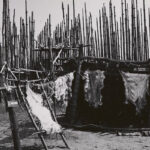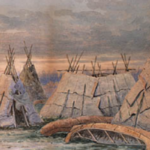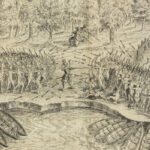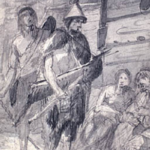The Tr’ondëk Hwëch’in First Nation, based in Dawson City, Yukon, embodies a rich tapestry of history, culture, and resilience. Their story spans millennia, from the early days of migration into the Yukon to the complexities of European contact and their emergence as a modern self-governing First Nation. This essay explores their history with an emphasis on prehistory, first European encounters, relationships with settlers, and their development into the contemporary era, highlighting cultural and historical continuity rather than political discourse.
Prehistory and Arrival in the Yukon
The Tr’ondëk Hwëch’in people belong to the Hän-speaking Athabaskan language group and have deep historical roots in the Yukon River valley. Archaeological evidence suggests that their ancestors have lived in the region for over 10,000 years, moving into the Yukon during the retreat of the Laurentide and Cordilleran ice sheets. This migration established a connection between the Tr’ondëk Hwëch’in and the Yukon’s vast landscapes, particularly at the confluence of the Klondike and Yukon Rivers (Greer, 1997).
Seasonal mobility was central to their way of life, as they moved between summer fishing camps and winter hunting grounds. Salmon runs were particularly important, not only as a primary food source but also as a cultural and spiritual cornerstone. The name “Tr’ondëk Hwëch’in,” which translates to “People of the River,” reflects this deep relationship with the Yukon River.
First Contact with Europeans
European contact began in the late 19th century, relatively late compared to other regions in Canada. Early interactions were shaped by the fur trade, with Hudson’s Bay Company traders establishing posts that facilitated economic exchanges. Tr’ondëk Hwëch’in hunters and trappers became key suppliers of furs, trading for goods such as metal tools, firearms, and textiles. This trade, while beneficial, also introduced diseases like smallpox and measles, which devastated Indigenous populations across the North (Sandlos & Keeling, 2021).
The most significant disruption came with the Klondike Gold Rush of 1896-1899. Dawson City emerged as the epicentre of a frenzied migration of prospectors, transforming the traditional lands of the Tr’ondëk Hwëch’in. The sudden influx of tens of thousands of settlers led to environmental degradation and the displacement of the Tr’ondëk Hwëch’in from their fishing camps at Tr’ochëk, a site of immense cultural significance.
Relationships with Settlers and Missionaries
The relationship between the Tr’ondëk Hwëch’in and settlers during the Gold Rush era was marked by both cooperation and conflict. Many Tr’ondëk Hwëch’in adapted to the changing economic landscape, providing guiding services, labour, and traditional knowledge to settlers. However, the imposition of settler governance systems and property laws marginalized Indigenous peoples and disrupted their traditional ways of life (Fafard & Le Blanc, 1999).
Christian missionaries, particularly Anglican and Roman Catholic clergy, sought to convert the Tr’ondëk Hwëch’in to Christianity. This often entailed efforts to suppress Indigenous spiritual practices. Some Tr’ondëk Hwëch’in adopted Christian beliefs, while others blended them with traditional spiritual customs. Despite these pressures, the community retained a strong sense of identity, rooted in their language, oral traditions, and connection to the land.
Transition to Modern Governance
The 20th century was a period of profound change and challenge for the Tr’ondëk Hwëch’in. Government policies of assimilation, including residential schools, forcibly removed children from their families and communities. Many Tr’ondëk Hwëch’in children were sent to distant schools, where they experienced cultural suppression and abuse. These policies inflicted deep scars on the community, yet the Tr’ondëk Hwëch’in persevered, maintaining their cultural identity and traditions.
The land claims movement of the 1970s and 1980s marked a turning point. The Tr’ondëk Hwëch’in joined other Yukon First Nations in negotiating land claims agreements with the federal and territorial governments. These negotiations culminated in the Tr’ondëk Hwëch’in Final Agreement, signed in 1998, which recognized their rights to self-governance and stewardship over their traditional territories (Maracle et al., 2018).
Contemporary Tr’ondëk Hwëch’in Society
Today, the Tr’ondëk Hwëch’in First Nation is a self-governing entity with a focus on cultural preservation, economic development, and environmental stewardship. The community is deeply involved in protecting and revitalizing the Hän language, which is considered endangered. Cultural programs emphasize the importance of oral history, traditional crafts, and subsistence practices such as salmon fishing and moose hunting.
The Tr’ondëk Hwëch’in are also leaders in environmental conservation. The protection of Tr’ochëk, now designated as a National Historic Site, reflects their commitment to preserving their heritage and the natural environment. Additionally, the First Nation has actively engaged in climate change adaptation efforts, recognizing the impacts of shifting ecosystems on their traditional ways of life (Gotthardt, 2022).
Economic development is another priority. The Tr’ondëk Hwëch’in have embraced tourism, promoting cultural experiences and eco-tourism initiatives in Dawson City and surrounding areas. Partnerships with local businesses and industries provide economic opportunities while respecting traditional values.
Conclusion
The history of the Tr’ondëk Hwëch’in First Nation is a story of resilience and adaptation. From their ancient roots along the Yukon River to the transformative impact of European contact and their modern achievements in self-governance, the Tr’ondëk Hwëch’in have navigated immense challenges while preserving their cultural identity. Their story underscores the enduring strength of Indigenous peoples and their vital contributions to Canada’s cultural and environmental heritage.
References
- Fafard, M., & Le Blanc, R. (1999). “Trade and Transformation: The Fur Trade and Indigenous Economies in Northern Canada.” Canadian Journal of Archaeology.
- Gotthardt, R. M. (2022). “Cultural Resilience and Climate Adaptation among Northern Indigenous Communities.” Arctic Review.
- Greer, S. C. (1997). “Hän Athabaskan Culture and Archaeology.” Yukon Anthropological Journal.
- Maracle, T. J., Tetlichi, G., & Kassi, N. (2018). Negotiating Self-Governance in Yukon: The Umbrella Final Agreement. University of Toronto Press.
- Sandlos, J., & Keeling, A. (2021). Mining Country: A History of Canada’s Mines and Miners. UBC Press.



